Anthony Metivier's Blog, page 28
October 25, 2018
Reach Any Memory Improvement Goal With These Atomic Habits From James Clear
 Do you struggle to reach your memory improvement goals? If so, you probably need “atomic habits.”
Do you struggle to reach your memory improvement goals? If so, you probably need “atomic habits.”
To help you have the best possible habits, in this episode of Magnetic Memory Method Podcast, you will hear from habit expert James Clear.
Here’s one of my favorite quotes:
“You do not rise to the level of your goals. You fall to the level of your systems.”
– James Clear
Who Is James Clear And What Are Atomic Habits?
James Clear is an author, entrepreneur, travel photographer and founder of The Habits Academy.
In this episode, James shares interesting topics and science-based ideas for living a better life, creating small habits and improving them.
James gives us a picture of how one can master and start a good habit. He also demonstrates just how much impact good habit formation is to achieving your goals.
If you are a person who fizzles through your to-do lists or suffers Digital Amnesia to the point that you can’t remember what you wanted to do at all, this episode with James Clear will definitely help and encourage you. James makes the habit formation process easy from the get-go and easy to maintain.
Learn more and discover how you can put these habits into action with consistency and improvement.
Press play now and you’ll discover:
How James started with Atomic Habits
What “Atomic Habits” means and how it can change your perspective of putting habits into action.
How you can create the best environment to make success easier
The importance of consistency and being organized.
The meaning of “system building” as a way to approach life improvement.
The wisdom of putting ideas into action.
How to handle criticisms in life.
How one can establish a habit and improve it over time.
Practical strategies for building habits.
The importance of mastering a habit and how you can dramatically save time in the process.
How building habits can impact decision making and your ability to continuously improve.
James Clear Resources
Atomic Habits by James Clear on Amazon
James Clear on Entrepreneur’s website
My Favorite James Clear Post Of All Time:
The Difference Between Professionals and Amateurs
Related Episodes:
How to Improve Focus And Concentration Using 3 Memory Boosting Habits
Joanna Jast On How To Hack Your Habits
The post Reach Any Memory Improvement Goal With These Atomic Habits From James Clear appeared first on Magnetic Memory Method - How to Memorize With A Memory Palace.
October 8, 2018
Optimizing Evernote And Other Productivity Software For Better Memory
 Evernote for better memory?
Evernote for better memory?
I was skeptical too.
Until I met Charles Byrd.
As a 15 year Silicon Valley veteran with an extensive background in technology and software, Charles needed Evernote to work better. His success demanded it.
But although Charles has some great things to teach us about optimizing Evernote for better memory, he’s also part of the larger memory improvement community. Just wait until you hear how he still uses lesson from Dominic O’Brien he learned a long time ago.
As a public speaker, trainer, and life long learner, Charles has combined his understanding of mnemonics with technology and productivity and become a recognized expert in the field.
He is also the founder of the company Byrd Word, LLC – specializing in productivity training, marketing, and technology to expand his reach. He specializes in the tools and workflows that will organize your team, reduce your anxiety, and x2 your business, school progress and personal improvement journey.

To learn more about how Charles can help you use Evernote in ways that improve your memory and productivity, I recommend his Kill the Chaos presentation.
Evernote For Memory Vs. Mind Mapping
After recording the interview with Charles, one of the first questions I had was how technologies like Evernote compare with Mind Mapping.
As you know, Mind Map Mastery is a worthy skill every lifelong learner should develop.
After you listen to this interview, I think you’ll have ideas on exactly how you can apply Charles’ core process to your mind map strategy.
Although how you would apply these techniques differ in time, what I love about the information Charles shares in this interview is that you can apply the “decision parameters” to all kinds of media.
Indeed, I am thinking about ways to combine mind maps with Memory Palaces and Evernote in one fell swoop as we speak.

This also includes how you use The Freedom Journal and other note-taking devices and approaches for organizing life in our current ocean of information overwhelm.
The simple process even applies to your memory training practice with Memory Palaces.
In many ways, I’ve been applying a similar process for years, but Charles has streamlined everything into a kind of ars combinatoria that any mnemonist can quickly link to their hand for use with any information you encounter in life.
Wouldn’t Evernote Cause More Digital Amnesia?
It’s a great question.
 The answer is…
The answer is…
It depends.
Digital Amnesia is a real issue, one that all mature learners in the 21st century face.
But as Charles demonstrates beyond all doubt, it’s more about our habits around technology than anything else.
In other words, we need to avoid the traps of technological determinism. We cannot blame the technology for how we behave. But we can use the technology to help ensure we operate in better ways.
Can Evernote Provide Brain Exercise?
Although we didn’t talk about this question on the interview, I’ve been thinking about it ever since.
When thinking about brain exercise apps, memory experts are divided.
As a question of application, I think this software certainly can be used for brain exercise.
As a quick example, imagine using Evernote to capture all of the 00-99 images you create based on the Major Method for your PAO.
Likewise, you could enter a number of mnemonic examples of Magnetic Imagery you’ve drawn and placed in a Magnetic Memory Palace for review in Evernote:
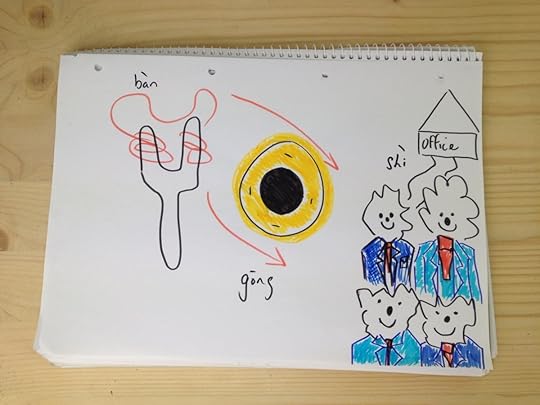
Then, simply schedule in a review period that exposes you to your drawings without revealing the answers. This is a fantastic way to keep learning and give your brain an extra workout throughout the day.
This process also provides a simple and direct way for you to challenge your brain without feeding it the information, all within a simple app.
The trick is in making sure you have some “desirable difficulty” as part of the process so that you’re challenged. Sans Forgetica has been working in this area recently around reading, and using obstacles to move your memory forward is what personally applied Memory Palace science is ultimately all about.
But if you’re looking for the best memory improvement exercises, just make sure that you match the desired outcome with the processes and the information that will get you there.
Further Memory Improvement Software Discussion & Resources
There are many other learning opportunities related to technology and memory on the Magnetic Memory Method site.
For language learning:
How to Consistently Get Quick Victories With Language Learning Courses
Learn Languages Online With Skill Silo And These 9 Fluency Tips
For General Technology and Human Memory Discussion:
7 Reasons Having A Memory Implant Would Really Suck
MyQuest For Your Memory Improvement
Why I Only Read Physical Books Instead of Digital Ebooks
In all cases, the danger I see above all in discussions like these is the human element. Whether its “organic” memory techniques like the Memory Palace or a software, we always risk too much self-involvement with the information.
So after listening to this podcast with Charles Byrd, I encourage you to think about how all of these strategies apply to you getting more out of your human relationships.
To that end:
I’d love to hear your thoughts and more about your memory improvement journey in the comments below.
The post Optimizing Evernote And Other Productivity Software For Better Memory appeared first on Magnetic Memory Method - How to Memorize With A Memory Palace.
October 4, 2018
How To Train Your Memory By Phil Chambers [Memory Improvement Book Review]
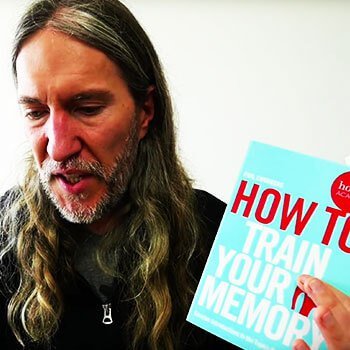 If you want to know how to train your memory, the journey to greatness begins with recognizing something odd about that brain between your ears:
If you want to know how to train your memory, the journey to greatness begins with recognizing something odd about that brain between your ears:
You sometimes forget enormous things!
That’s how Phil Chambers begins his fantastic book, How to Train Your Memory.
When you start your memory improvement journey by acknowledging just how easy it is to forget where you parked your car, you start from practical realities we all face.
After all, vehicles are the biggest things we own apart from our homes.
Yet, the location of a car can still easily disappear from memory!
Acknowledging this fact gives us a sense of just how strange and mysterious an entity you’re dealing with.
Of course, there’s something even bigger than cars and houses we forget that How To Train Your Memory helped me recognize, but we’ll get to that in just a bit.

First, let’s talk about:
Why You Should Learn How To Improve
Memory Recall From Memory Expert Phil Chambers
It’s a good question, and a delight to answer.
First off, Phil’s a great writer. When learning how to improve memory and concentration, clarity matters.
Second, Phil’s got street cred.
More than being a leading memory expert, he’s the Chief Arbiter of the World Memory Championships. We talked a few years ago about what this role involves in the interview called Phil Chambers and the Outer Limits of Memory.
Phil is also one of the few memory trainers who has thought deeply about combining Memory Palaces with Mind Maps. He is a World Mind Mapping Champion, after all, and author of the incredible guide, 101 Top Tips For Better Mind Maps.
And if that wasn’t enough, get this:
Phil has taught memory improvement and mind mapping alongside Tony Buzan himself for many years. In fact, I made it a point to attend a live Thinkbuzan training and learned more than I ever would have dreamed possible.
Having them both in the same room is a blessing you won’t want to miss!
Why Memory Training Is The Best Way To Improve Memory And Concentration
I remember taking courses with the filmmakers Atom Egoyan and Peter Greenaway while studying at the European Graduate School.
Both of them have encyclopedia knowledge of Film History.
But because I know how to convert semantic memory into episodic memory, I listened to those lectures differently than my fellow students.
Sure, I took notes using my approach to note taking.
But using the same tools Phil talks about in How to Train Your Memory, I remembered tons of names and details simply because I was actively connecting imagery with the information as the professors spoke.
And I was able to do so even though I was star struck to be in the same seminar rooms with these legends of cinema.
Kind of like how I was star struck to be in a room with Phill and Tony!
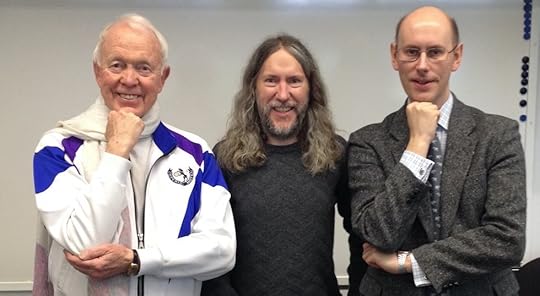
In other words, using memory techniques help you zone in on details by using association that pushes away distractions.
Phil explains why and how association works. He also gives additional tips and examples that will help you. One skill in particular that you’ll get better at after reading this book is the one that matters the most:
The ability to convert abstract information into concrete images better and faster.
How does Phil’s book help you develop this skill?
Each chapter gives you exercises to complete.
And you really should complete them.
In fact, getting a physical copy of How To Train Your Memory will help make sure you complete the exercises. I talk about why I’ve been reading only from physical books for memory training here:
(Oh, and physical books make it easier to use the Major System to memorize page numbers so you can easily find good passages you want read again.)
When Acronyms For Learning Help Your Memory Excel &
When They Lead To Failure
One of my favorite parts of How to Train Your Memory is when Phil Chambers lays out the pros and cons on using acronyms for memory training.
Basically, it comes down to calculating the margin for error.
The same thing goes for using rhyming as a memory technique. Sure, it can work, but when using mnemonic devices, too many things can go wrong.
Why?
It comes back to the science of memory:
If you don’t convert semantic information into episodic memory through the use of mental imagery, you will find it harder to reproduce.
But there is one acronym that Phil gives us that demonstrates when this technique is super powerful, and I’d like to demonstrate how and why.

The acronym is SEAHORSE.
You’ll need to read the book to learn the memory training lessons packed into that single word, but when you get it right, you’ll have the keys to the memory improvement kingdom permanently locked into your mind.
The reason why this acronym works so well is that:
1. The mnemonic acronym SEAHORSE creates an image. You can picture the creature in your mind.
2. SEAHORSE creates an image that looks like a part of the brain that plays a huge role in memory.
This is the hippocampus, which is names in Greek after its resemblance to the animal. (Hippo = horse and kampos = sea monster).
3. You can connect the SEAHORSE acronym to the author himself when you realize that the name Phillip (i.e. Phil Chambers) relates to the word hippocampus.
How To Use A Mnemonic Acronym In A Memory Palace
As I’ve already shared, I’ve met Phil Chambers in a room. In fact, Phil and our group turned that room and its surrounding area into a Memory Palace.
Now I can use it again and see where Phil sat in the room. I can place the image of a Seahorse over his head to remember the acronym.
I can also place as a hippopotamus with a horse’s mane over his left shoulder and a camping tent over his right shoulder.
These images remind me of the Greek word origin of hippocampus. I am encoding both the sound and meanings of these words by converting facts into images.
These images automatically receive episodic memory characteristics.
This “transfer” happens because:
There is a story behind why I was in that room.
The stories I know about Phil
The “image-story” of why a hippo would have a horse’s mane in the first place (it’s because the seahorse in his brain is driving him insane…)

This image-story takes just a few seconds to generate.
And yes, my brain is aided by the fact that I’ve met Phil and I’m drawing upon neurochemical changes.
This is why you should focus on drawing from your own experiences too. It’s related to the multi-sensory memory experiences fellow memory expert Nelson Dellis talks about in Remember It!
Then, by charting out 8 Magnetic Stations throughout the room, I can then layer on some Magnetic Imagery for the parts of the acronym itself.
For example, the first word of SEAHORSE is “Senses.” In the corner of the seminar room, I can see Superman. He is tasting his hearing aid while blind and suffering from a belly ache.
Why? Because a blind Superman tasting a hearing aid while in pain reminds me of most of the senses. I can even change his name to Super-Sense-Man to tap into the cognitive mode of the mind and memory and seal the deal.
All that needs to happen next is to move to the next station and create a memorable image for the acronym word that starts with “E.”
The Fullest History Of The Major System In The World
I’m a huge fan of the Major System and use it every day in the memory training I use based on memory training techniques from around the world. Even if it feels invisible, the Major (or Major Method) is actually behind the 00-99 I use for phone numbers, playing cards, birthdates and everything based on digits.
I learned a lot from reading Phil’s take on both the history of the Major and how he mixes it with the number-shape technique.
Why is the history of our tradition so important?
Easy:
Knowing the story of the memory tools you use gives you even more mental connections and imagery!
In terms of the actual technique, Phil points out something that I try to make sure everyone understands:
The techniques you use for competition are not necessarily the same as the ones you would use in every day life or for large learning projects.
Before I continue, let’s review the Major Method. There are some variations and different approaches to the Major System, but this arrangement is quite common:
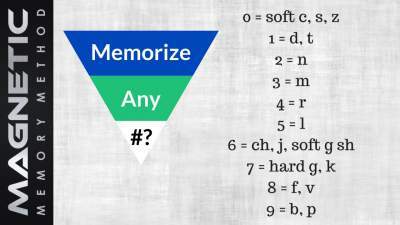
Now, for many people learning how to memorize numbers, this approach will be more than enough for daily life. Except…
How do you deal with 3 digit numbers without creating a 000-999?
Phil demonstrates exactly how to do it in ways that I do all the time. For example, 358 would be the mail man based on the Major and a snowman based on the number-shape technique.
For me, 35 is the mail man Mr. McFeely from Mr. Rogers Neighborhood. So I just see him shoving envelopes into Frosty the Snowman.
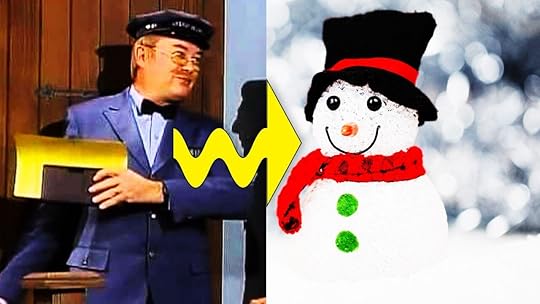
However, here’s the problem:
In a competition setting, the context might tempt you to mix and match the Major with the number-shape technique and impoverish your results.
And that’s exactly what happened to me when Phil gave us a number memory test. I was half-using the Major and half-using the number-shape approach.
In real life, when you have time to review your images and re-shape them when needed, no big deal. But when the heat is on during a competition, there simply isn’t time. You are working at the level of practical strategy.
Both involve what Phil describes as “creative innovation.”
But in the case of competition, you need your mnemonic systems set up and well-practiced in advance for competition purposes. Learning life is usually – though not always – more forgiving.
Mind Maps For Memory Training & Memory Improvement?
One of my favorite parts of How to Train Your Memory involves the limitations mind mapping has for memory improvement.
Phil explains the ins-and-outs clearly and continues giving incredible tips.
And the best part is this:
The book includes a number of his own mind maps that explain the memory techniques taught in the book. It’s also a great supplement to Tony Buzan’s Mind Map Mastery.
In sum, Phil gives you a decision matrix for knowing when to use mind maps for memory and when to go to more dedicated techniques and strategies.
More and more, I’ve been thinking about what I’ve learned from him about mind mapping and often impose a “mnemonic clock” on the page built from the Major so that each position has a ready made image.
For example, 12 is Tin Tin, 13 (one-o-clock) is J. Edgar Hoover vacuuming the Hoover Damn with a Hoover vacuum, etc.
Although this approach is a bit rigid, as Tony Buzan said while I trained with this Dynamic Duo of memory improvement, “The Rules Will Set You Free.”
And as Phil makes clear, the context in which you choose the rules you will follow matters the most above all.
Why You Need To Read How To Train Your Memory
Memory training is a bit of an odd world.
On the one hand, there are many books you can read and be set for life. You just need to keep using the techniques you’ve learned.
On the other hand, there’s always more to learn and top performers in every field constantly revisit old ideas and scour the world for new angles.
Plus, we simply don’t know what we don’t know.
That’s why I’ve was delighted to re-experience some familiar concepts through a new lens in How To Train Your Memory and learn things I didn’t know before.
I highly recommend you do the same.
Oh, and about that issue with people forgetting things bigger than their car or their house.
It’s this:
People forget to pursue their passions.
That’s even stranger than forgetting where you parked.
And if your passion involves the need for better memory (how could it not?), make sure you read How To Train Your Memory by Phil Chambers.
The post How To Train Your Memory By Phil Chambers [Memory Improvement Book Review] appeared first on Magnetic Memory Method - How to Memorize With A Memory Palace.
September 26, 2018
Nelson Dellis On Remember It! And Visual Memory Techniques
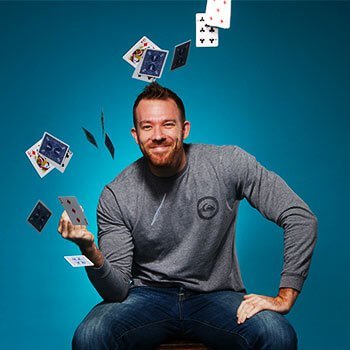 Looking for visual memory techniques?
Looking for visual memory techniques?
And I mean truly visual.
In this episode of the Magnetic Memory Method Podcast, Nelson Dellis takes us behind the scenes of his new book, Remember It!
No kidding:
It is the most visual memory improvement book I have ever seen.
Even better, Nelson shares his unique way of using the Memory Palace technique to get the best results for both competition and learning.
All on an incredibly visual basis unlike anything we’ve seen since Bruno’s On the Shadows of the Ideas (and then some).
I really appreciate the visual memory techniques in Nelson’s new book for the way it will help so many people who get lost in the technical details involved in memory techniques.
No one is to blame for that. It does have it’s “cerebral” aspects and we’ve needed people who can teach that.
But never before has someone both exposed the need for visual training we all need and taken so much care and attention into making mnemonic examples truly visual.
Seriously, Remember It! is almost like a visual mnemonics dictionary.
But you might be asking yourself…
Who is This Nelson Dellis Anyway?
Some Kind Of Memory Champion?
As a matter of fact, yes.
And he’s got some of the best memory improvement tips in town. Here’s a quick summary of some of the best:

You see? Nelson’s even inspired me to up my game and get more visual too. Hence this infographic summary. Thanks Nelson!
More Reasons I Find Nelson Dellis Inspiring And Influential
For The Life-Long Study Of Mnemonics
Nelson Dellis is a 4x USA Memory Champion, Memory Athlete, Memory Consultant, Published Author and highly sought-after Keynote Speaker.
Nelson is also the Founder & CEO of Climb For Memory, a non-profit charity that aims to raise awareness and funds for Alzheimer’s disease research. He does this through mountain climbs all around the world.
Nelson approaches memory techniques scientifically and as part of living a good and healthy life.
If you’d like to learn more of the memory techniques Nelson has crafted for himself and how imagination can play a big role in your memory improvement, download this podcast now.
No. Wait. First do this:
Order a copy of Nelson’s new book, Remember It!
Oh okay… still not convinced?
Press play now and you’ll discover:
Exactly what inspired Nelson to write down his approach to championship-level memory techniques
How the visual memory techniques illustrated in Remember It can help you better understand memory techniques
How to make use of all your senses for memory improvement
The importance of establishing and keeping trust in your memory
How physical objects can help your memory
Different ways of managing Memory Palaces and making sure they are truly visual
The true meaning of “Multiple Memory Palaces” and why you must create a number of them (never rely on just one)
How to use the “Body Peg List” in an interesting way
How the alphabet can help in remembering
Tips on quick memorization for when you just have to Remember It!
If you want to see Remember It and just how visual it is, check out this video:
3 Reasons Nelson’s Visual Memory Techniques Are The Best So Far
Let’s face it:
1. There are thousands of books and programs on memory improvement.
But never before has anyone gone to any great length to make their mnemonic examples leap from the page.
Nelson does.
And this is very powerful because you sense through your eyes what needs to be happening in your mind.
2. Even if you have aphantasia, Nelson’s book will help.
This is because Nelson makes it clear that memory techniques are always visual for all people, and all people are visual. Yes, no matter what.
But he also makes it clear that you need to make your approach multi-sensory.
And he gives you great ways to dive in and experience memory techniques. The visual prompts make it difficult not to want to give them a try.
3. Nelson is aware of the real value of memorization techniques.
It’s not just about winning prizes, learning languages or conquering your exams at school.
It’s about conquering life itself.
And to do that, you’ve got to bring the body and the mind together.
Should You Buy Remember It?
In a word, “yes!”
Remember It will become your go-to book for ideas, inspiration, guidance and strategic know-how.
You’ll discover the best mix of scientifically proven visual memory techniques with practical application in both memory competition and in life.
Grab it from your favorite local or online bookseller now and then reach out and let Nelson know loud and clear that you appreciate with a review on Amazon and a follow across his presence on the web.
Well… What are you waiting for!?!
Get started with these resources now!
September 19, 2018
Teach Yourself Using The Best Language Learning Books By Olly Richards
 Looking to teach yourself a foreign language and need the best language learning books? Let me introduce you to my friend Olly Richards.
Looking to teach yourself a foreign language and need the best language learning books? Let me introduce you to my friend Olly Richards.
Well, they’re aren’t necessarily.
Unless they’re built by someone who deeply understands the needs of language learners.
Enter Olly:
He’s the man behind the new Teach Yourself Short Stories For Beginners series.
He’s also the man behind the hit blog and podcast, I Will Teach You A Language.
But still I hear you asking…
Why are his short story books the best language learning books?
Well, here’s just one reason that Olly mentions in this episode of the Magnetic Memory Method Podcast:
“A book that is on your lap, and is exciting and contains lots of stories that make you want to read, is a an unbeatable source of continuous learning in the language.”
How does a book make you want to read?
That is exactly what you’re about to find out.
Even better:
In this episode, Olly Richards gives us interesting tips and techniques about language learning through his great new Short Stories for Beginners language learning books.
Discover The Best Language Learning Books
From A Master Polyglot And Learning Expert
Olly Richards is the founder of I Will Teach You A Language and speaks 8 languages. He started learning his first foreign language at age 19 when he bought a one-way ticket to Paris.

And now you can discover the keys to quickly and easily learn any language with Olly by selecting the most effective language learning books.
Press play now and you’ll discover:
Simple techniques to learn new languages quickly
The power of story in language learning and how to choose the best language learning books
The important skills your need for learning any language fast
How to develop reading skills in the language

How to get confidence in speaking a language
How to learn a foreign language by growing your vocabulary in a simple way
Techniques for improving your comprehension (remember, bilingualism is good for brain exercise and brain health)
Simple short stories for beginner level learners
How to find fun resources for learning new languages
Tips to keep you motivated in learning the language
It was also a great honor to be invited to read from Short Stories in German during Olly’s Festival of Reading:
It’s been awhile since I’ve had a chance to speak in German, but it seems like my memory for this beautiful language is holding up. So grateful to have some cool stories to read auf Deutsch – thanks Olly!
To be one of the first to get Olly’s new series of books, claim up to $777 in language learning courses now.
Further Resources For Language Learners:
Related Language Learning Episodes:
Olly Richards Talks About Language Tech And Real Communication
Stoic Memory Improvement Secrets For Language Learners
The Freedom Journal For Language Learning
The post Teach Yourself Using The Best Language Learning Books By Olly Richards appeared first on Magnetic Memory Method - How to Memorize With A Memory Palace.
September 12, 2018
Mind Map Mastery: 10 Tony Buzan Mind Mapping Laws You Should Follow
 A lot of people search the Internet for Mind Map software. And that’s great… provided they’re getting it from Tony Buzan. Most especially when you’ve read his book, Mind Map Mastery.
A lot of people search the Internet for Mind Map software. And that’s great… provided they’re getting it from Tony Buzan. Most especially when you’ve read his book, Mind Map Mastery.
Why read this book?
First of all:
No one else alive has thought so thoroughly through this incredible technique for externalizing the brain and interacting with it.
Even better, no one else has shown so thoroughly how:
A proper Mind Map boosts creativity.
How Mind Mapping as a practice improves memory.
How the process of mind mapping sets you mentally free (more on that in a bit).
It gets better too because…
No one has given more Mind Mapping examples than Tony Buzan.
And in Mind Map Mastery, Tony Buzan provides exactly what the subtitle of this book promises:
The Complete Guide To Learning And Using
The Most Powerful Thinking Tool In The Universe!
In this extensive book review, you’re about to discover:
* Why Tony Buzan’s Mind Map Mastery delivers on this promise
* Why making your thoughts visible eliminates mental exhaustion
* Why colors create mental focus and energy
* How simple limits create an infinity of ideas
* How a proper Mind Map can serve as a Memory Palace
* Bonus: How to fuse a Tony Buzan Mind Map with the Major System!
If all that sounds good to you, please read every word on this page. I promise I will earn your agreement that Mind Map Mastery by Tony Buzan is the most important book in the world!
The Future Of Mind Mapping Begins With The Past
Tony Buzan begins Mind Map Mastery with a short history.
And in case you’re wondering, yes, “history” is the right word.
Buzan has been teaching the skills of mind mapping for quite some time. Just check out this video from 1974:
This video is from the same year Use Your Head appeared. This is what one of its many book covers looked like:
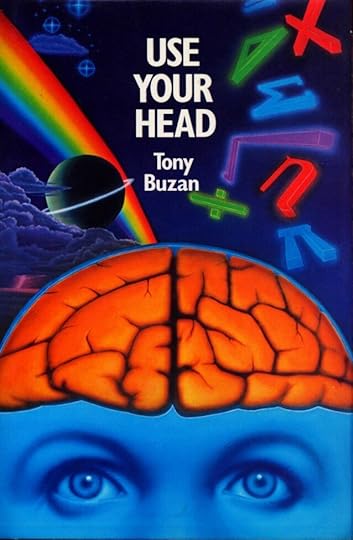
As he explains in the latest book we’re discussing today (released 44 years later!), the Mind Map emerged from an understanding of the brain as a spatial arrangement of neurons.
But That Realization Didn’t Happen Overnight!
And Buzan drew upon other influences to arrive at this powerful conclusion. For example:
Buzan’s understanding of the method of loci was integrated into mind mapping.
Buzan also encountered the Major System from day one of university.
(The Major is also spatial in many ways. More on that with these 3 Powerful Memory Techniques For Memorizing Numbers.)
With the method of loci that underlies the Memory Palace technique and the Major, Tony Buzan brought the first Mind Map to life.
Yet… there was a problem!
How Tony Buzan Solved Problems With The Early Mind Map
As Buzan reflects, his first Mind Maps had problems.
In his words, they were “monochromatic, monotone and monotonous.”
Worse… he struggled to answer this question:
Is Mind Mapping Note-Taking?
In short, no. Far from it.
In essence, Buzan had revolutionized note-taking.
But for Buzan, this was not good enough. So Tony Buzan did what all great innovators do:
He showed the technique to others, particularly learners left behind by the system.
Next, Buzan observed how these learned used his early mind maps to improve their lives.
Finally, Buzan took his observations back to the Mind Mapping process so he could improve the technique.
How Tony Buzan Mind Maps Mimic The Organic
Brain Better Than Any Software
As we know from many great geniuses, solvitur ambulando.
That phrase means, “it is solved by walking.” Here’s how I memorized that term:
And solve the problems with mind mapping by walking is exactly what Tony Buzan did:
To help himself understand more about why his early Mind Maps were helping people, he walked in nature.
As a result, thoughts about how to better “mirror” the cellular nature of the brain on paper emerged.
Radiant Thinking
Observing the Mind Maps combined with walking and reflecting led to revelations about “Radiant Thinking.”
By giving people a means of connecting thoughts on paper like the brain connects ideas through cells, Mind Mapping broke free from note-taking.
Like the brain when it is operating at its full power, “Radiant Thinking” through Mind Mapping is:
Multi-faceted
Colorful
Associative
Multidimensional
Verbal and Pictorial
Imaginative and Analytical
Isn’t that exciting! Imagine being able to think in these ways all at the same time without the costs of multi-tasking!
The good news is this:
You can!
Tony Buzan Use Your Head Secrets Mixed With The Laws Of Mind Mapping
For all of these accomplishments, there was still a problem…
No matter how clear the instructions…
Some people are teaching Mind Mapping without understanding the method.
Instead of following the Laws of Mind Mapping, they are calling other techniques like these mind maps:
Spider Diagrams
Pyramid Diagrams
Concept Maps
Fishbone Diagrams
Sunburst Charts
To be clear:
None Of These Techniques Count As Mind Maps!
Look, there’s nothing wrong with using such visualizations, but to call them Mind Maps can never mirror the human brain cell.
Think about it:
What does a spider have to do with mind mapping? With human thought? With human memory?
Spiders are fantastic, but if we know one thing about human memory and learning going back to Ad Herrenium, it’s that metaphors matter.
For that, I’m glad Tony Buzan wrote Mind Map Mastery to help correct the record.
He reminds us of the Laws of Mind Mapping. He refocuses our attention on why they mirror the neuron, the central location of thought.
The Natural Reason Why Mind Maps Must Have A Central Image
Like a brain cell, a Mind Map must have a center. Without a central image, your Mind Map has no focus.
Without color, the Mind Map lacks power. Imagine going on a walk through nature in black and white.
A Fishbone Diagram built from straight-lines has nothing to do with the curves of human thought.
Concept Maps are usually overloaded with words (I am often guilty of this). As a result, they quickly become unwieldy, awkward and collapse.
Without care for balance and distribution, a Pyramid Diagram places your focus on concentrated areas. These do not help your brain create new solutions or remember more.
Would You Like An Abundance Of Mind Mapping Examples?
Tony Buzan demonstrates the validity of his claims with nearly two dozen examples.
The images in Mind Map Mastery are just as they should be:
Clear
Balanced
Colorful
Keyword focused
Evocative
Understandable at a glance
Compelling
Easy to emulate as you create your own
How Mind Map Mastery Helped Me Improve My Practice
To be honest, I’m like a lot of learners.
I get a few tips and put them haphazardly into play.
This is NOT a problem.
If anything, it is a blessing.
But no serious, mature learner can stop there.
You’ve got to return to the well of knowledge and refine your practice.
Here’s a Mind Map example from 2015 shortly after I met Tony Buzan at a ThinkBuzan training.

Then I recorded a chat with Phil Chambers about how to combine Mind Maps with Memory Palaces.
So, what’s the problem here?
After all, I used this Mind Map to:
* Write a book
* Turn the book into a video course
* Launch the course successfully with Jonathan Levi.
(This Mind Map is the first brainstorm of what became Conquering Content in Branding You Academy.)
Yet, for all that success, there are quite a few problems.
The Whole Mind Map Is Overloaded (For One Thing)
Yes, there are colors, but…
I had attended the ThinkBuzan training to learn about memory.
We did a bit of Mind Mapping, but I was so focused on the memory aspect (and not embarrassing myself) that not all the lessons got through.
And I’m just one of those learners who need to go back to the well and refine my practice through repeat exposure. For this reason, I still reread one book per month.
But… I had yet to go back to THE ultimate book on mind mapping I’d read as a kid. This lapse happened mainly because I was revisiting Buzan’s books on memory.
And I hadn’t quite learned enough Chinese to read him in Mandarin, even if he was suddenly following me everywhere!
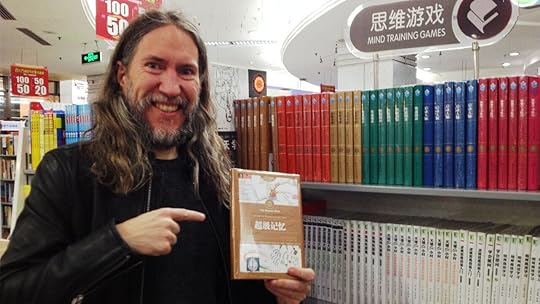
My lack of attention to the Laws of Mind Mapping was tragic. It meant that I wasn’t getting nearly the results that I could have been.
So even though my mind mapping was successful, it was still dampened.
Then came the incredible announcement of Mind Map Mastery. I ordered it immediately.
The wait inspired me to revisit Mind Mapping in earnest.
Perhaps pretentiously, I released this video:
But what I’m talking about wasn’t advanced at all!
Though there is one virtue evident in every word I speak in the video.
Here’s why:
I was advancing my skills and practice by taking it one S.I.P. at a time (study, implement, practice).
Then, when Mind Map Mastery finally arrived, I started reading it.
I applied what it said, and before you know it, my Mind Maps improved!
Here’s a Mind Map example from one of the best YouTube Livestreams I’ve ever held:

(If you want to watch this replay and join future live streams, here’s the memory improvement books ultimate list hangout replay for you. Click subscribe and choose to be notified so you can join us next time we go live.)
What Made This Mind Map Better Than Any I’d Created Before?
The answer is simple. I just followed…
How to Mind Map Using The 10 Laws Of Mind Mapping
One: Blank paper in the landscape orientation.
Why is blank paper so important?
I believe it’s because the chemical makeup of the brain is more closely related to paper than, say, computer.
Also, the inner landscape of the mind is unlined. If you use lined paper, you are placing a barrier between your thoughts and the laws of mind mapping.
Landscape orientation is critical too because we see the world horizontally more than vertically. Peripheral vision is freer left-right than it is up and down.
I also believe landscape orientation allows for greater mirroring of another essential structure:
The clock. It is the clock formation that lets us instantly turn any Mind Map into a Memory Palace at a glance.
Two: Draw a central image in the center.

Tony Buzan says that the central image should feature at least three colors.
It’s a subtle point and one that I’ve missed many times. I look forward to putting it into practice many times in the future and observing the improvements.
The image should express your core concern with the Mind Map.
Three: Different images should appear throughout the Mind Map.
You should also use dimensions, such as drawing some of your keywords in 3D.
Four: Keywords should be capitalized.
For some reason, this is one of the toughest laws for me to follow. Maybe I read too much e..e. cummings when I was in high school.
September 5, 2018
Can You Really Improve Memory Like Sherlock Holmes? [Actionable 11 Point Checklist]
 Imagine receiving thousands of emails from people asking you, “Can you really improve memory like Sherlock Holmes?”
Imagine receiving thousands of emails from people asking you, “Can you really improve memory like Sherlock Holmes?”
What would you tell them?
Would you say…
“Oh yes, of course. Just use the best memorization technique all the hip kids are using these days.”
Or would you say…
“Sorry. Too busy. I must go to my Mind Palace!”
Well, as the man with all the memory exercises and memory improvement know-how…
I have to take a third path.
And I always give people an answer that breaks my heart!
But here’s the truth of the matter…
You Can’t Improve Memory Like
Sherlock Holmes Because…
The Dude Isn’t Real!
Seriously.
How can any honest and ethical person tell you that such a thing is possible?
How can you create a Memory Palace (or Mind Palace) like Sherlock Holmes and experience substantial memory improvement when that person doesn’t exist?
And yet other memory trainers use this metaphor all the time.
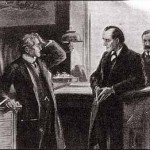
They use it as their “marketing hook.”
That’s right.
And even if it’s false advertising, it works.
But what those marketers are really saying is something more like this:
“Hey, how would you like to memorize information like a fictional coke addict who walks with a cane?”
Worse:
“How about becoming like someone who treats his sidekick Watson like a dim-witted moron?”
No thanks.
I don’t know about you, but…
I Want Real Memory Improvement!
And as much as I’d like to stop the misrepresentation of the real glory of memory techniques, the world of marketing is what it is. Unless you know how to memorize these classical copywriting headlines.
So…
I suggest you remember Caveat Emptor in the wild world of online memory training.
But here’s the very good news:
If you want to know about a memory method that really will help you improve memory, you’re in the right place.
After all, memory isn’t really at the core of Sherlock Holmes.
Here’s the real deal:

It was medical deduction for the diagnosis of disease that influenced Arthur Conan Doyle, not detective work. And it’s this kind of medical detective the books and movies really base themselves on.
All that aside, here’s what we’ll be doing in this Sherlock Holmes continuation post:
I’m going to provide you with an 11-Point checklist that will make sure you’re on the right track.
Are you ready to get started?
You are?
Great!
Let’s go!
The Ultimate 11 Point Improve Memory Checklist
So with all that ground covered, let’s get started with the ultimate checklist for improving your memory.
Do all these things and you’re guaranteed to have a memory sharper than you ever dreamed possible!
1. Learn the Memory Palace technique first.
Why?
A few reasons.
First, there are a lot of terms out there for the different memorization techniques you can learn.
But the Memory Palace is the only one that taps into the most significant memory power:
Spatial memory.
Second, the Memory Palace enables you to use the other memory techniques you’ll learn about inside them.
I’m talking about the link method, the Major System, the mnemonic peg system and so on. There are lots of terms and we’ve clarified them in this post with 5 Memory Palace Examples To Improve Your Memory Training Practice.
Why seek so much clarity?
So we can master the fundamentals first. That’s how the Magnetic Memory Method ensures you can actually use the skills for life.
Without struggle.
Without constant questions about what to do and how to do it.
Without fear of making mistakes at every corner.
The Major Path To Fast Success With Memory Improvement
2. Learn the Major System.
“The Major” as the memory technique veterans refer to it involves associating numbers with letters of the alphabet.
The Major has also been called the phonetic mnemonic system and the digit-consonant system.
Whatever you call it, here’s what it looks like:

Why learn to memorize numbers?
First, even in the age of smartphones and online calculators, they’re still super-important.
You still need to know the phone numbers of your loved ones in case you lose your device.
Not only that, but when you create a Magnetic Memory Palace, you can give each Magnetic Station within a number.
That way, when you’re using the Memory Palace to encode and decode the information, it’s easy to move directly to the information you placed inside.
Once you have the Major System working, you’ll also be able to:
Remember passwords
Bank account numbers
Historical dates and birthdays
Appointments
Addresses
… and anything else involving numbers!
To make this happen, you’ll want to create what some people call a P.A.O or a 00-99 list.
If you’d like more information, I’ve included my own mnemonic examples in How to Memorize Math, Numbers, Simple Arithmetic and Equations.
How To Memorize History:
Mnemonic Example Of How Having A “Magnetic” 00-99 P.A.O.
When you have a proper 00-99, any time you see a number, you instantly have a Person, and action and on object pop into your mind.
This simple mnemonic tool is better than any vitamins for memory improvement on the market.
For example, I wanted to memorize some dates about George Washington not too long ago while reading Richard Brookhiser’s book on Washington’s leadership skills.

According to Brookhiser, Congress made Washington Commander in Chief of the military in 1775. This post lasted until 1783.
I instantly memorized these dates by placing some Magnetic Imagery in a Memory Palace.
The mnemonic examples I used?
First, I used my image of George Washington himself. I’ve seen paintings and stone carvings of the dude, so I have a relatively decent idea of how he looks.
How To Mix Major System P.A.O. Mnemonics For Historical Dates
Second, I needed to remember that 17 is involved because these dates took place in the 1700s.
To do that, I have George Washington equipped with some very sharp tacks.
In the Major Method, 1 = d or t and 7 = k.
Put those two together to form a word like “tack.”
Next, to this image of George Washington with tacks, I have him shoving these into John Cale.
Yeah, that hurts, and that’s why it’s memorable (Sorry John Cale!)
Now, you might not know John Cale or his loose relationship to the history of binaural beats via Lou Reed, which is why you need to get into real memory training. It will help you instantly create these associations when you need them.
The point is that Cale (pronounced “kale”) starts with a hard “k” sound and ends with an “l.”
That’s perfect because all I need to do is think of George Washington putting tacks into Cale in my Memory Palace and then I can recall 1775 in a snap.
Just Get Started And The Rules of The Major System Will Set You Free

You can do this too if you dive into these techniques and start creating your associations from 00-99. Don’t overthink it. As my mentor, Tony Buzan says, “the rules will set you free.”
Briefly, I know this period for Washington ended in 1783 (according to Brookheiser) because, in the same Memory Palace, I can sense George Washington interacting strangely with George Orwell.
George Orwell wrote “Animal Farm” and he is spraying “foam” at the cast of “fame” in this image.
Why?
Because F = 8 in the Major System and 3 = M. “Farm,” “foam” and “Fame” all compound together to make the association bulletproof.
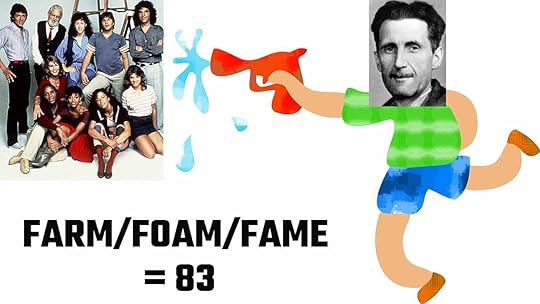
Brookheiser tells us that the actual Washington presidency took place between 1789 and 1797, two numbers I now know by heart.
Why? Well, as strange as it is:
I see Cobra Commander with his viper symbol bashing Peter Parker with a puck.
Viper = 89
Parker/puck = 97
It’s that simple. Every 2-digit number has an image like this. All that needs to happen in your mind is this:
Get them interacting in weird and unusual ways in a Memory Palace. With a small amount of practice, you’ll learn to remember vast amounts of information.
Ever hear Sherlock Holmes talk about doing stuff like this in his “Mind Palace?”
No way, hombre. Sherlock Holmes isn’t real.
3. Learn Recall Rehearsal (a.k.a. Spaced Repetition)
You know why we call it “Recall Rehearsal” in the Magnetic Memory Method universe.
A few reasons:
First, it doesn’t count as spaced repetition. That sounds hard, annoying and… lame.
Second, a well-formed Magnetic Memory Palace Network is like a series of theaters.
In these theaters, you call your players for “rehearsal.”
So when I ask my mind about the dates for George Washington’s terms as a military commander and the first President of the United States…
I’m NOT replaying a movie.
No, I’m a theatre director. I know which theatre the play takes place in and I call my actors to the stage.
Then I ask:
What were they doing there?
Why?
How?
And other questions to trigger back the associations.
And I do it only as many times as needed to get the information into long-term memory for as long as I need the info.
But spaced-repetition…
I find it’s a waste of time without Magnetic Imagery involved.
Plus, Recall Rehearsal puts the Magnetic in the Magnetic Memory Method by making it easy, fun and effective.
And it’s the only way to develop a mnemonics dictionary in your mind for instant and rapid use of memory techniques.
Dominic O’Brien And The Rule Of Five
With practice, you can reduce the number of repetitions needed to a shockingly low level, though of course, Dominic O’Brien’s Rule of Five is worth your attention, but…
Don’t go wishing and praying for a magic number.
Learn these skills for yourself and the principles that make them work.
That’s the fast and easy path to real memory magic. And it’s better than even the best improve memory games on the market.
But some other guy’s “memory system” or spaced-repetition number will never be as robust as your own. Earn the success you want through experience. It’s a beautiful thing.
More on How To Improve Memory Recall Better Than Sherlock Holmes
Now that you know the truth about using a Memory Palace and use it to place information into long-term memory, here are some additional tips that will help.
Pay attention to each of these because they are essential to your success. These tips are critical to the long-term health of your brain and memory.
4. Eat a memory-friendly diet.
It’s true:
Foods that improve memory – and foods you should avoid – can make or break your memory.
Walnuts, blueberries, green tea – these have all been shown to give your memory a boost better than any improve memory supplements on the market.
5. Exercise.
I go to the gym three days a week. It keeps my body fit, as well as my brain.
The best part?
I’m able to perform Recall Rehearsal while pumping iron and hitting the treadmill.
I also walk frequently and do pushups and yoga at home.
Every bit of fitness helps protect your brain and memory.
6. Reduce Multitasking
(Except when using the particular form of multitasking in a Memory Place we’ve been talking about today.)
Seriously. People who want to learn faster are damaging their chances of success by holding multiple open tabs and reading from devices enabled with notification options.
Speaking of which…
7. Sleep Without Devices In Your Room
If you want to improve your memory, improve your sleep.
It seems unrealistic these days, but it’s getting more important every day:
We need to unplug from the Internet.
We need time away from the machines that use algorithms to shape what we see and how we think.
Personally, every time I stray from my computer curfew…
I regret it.
Not only does my memory suffer…
I make bad decisions.
I get a bit paranoid.
I feel less well.
By protecting the bedroom and using my re-reading strategy with real books, I create a buffer zone around my sleep that works very well.
Oh, and I use a sleeping mask too. Highly recommended.
8. Use app-free brain exercises
Brain exercises are important. And the best evidence shows that when you use apps to get it…
You’re getting horrible results.
The only ones ever shown to work in any impressive way set you up with one-on-one coaching on the other end. In other words, it’s not the app alone getting you the mental fitness results.
But if you’re willing to learn some of these brain exercises, you’ll quickly find boosts in focus, attention and memory.
I’ve shared many exercises to improve memory and concentration, so please be sure to listen to the Magnetic Memory Method Podcast frequently so you don’t miss any of them.
9. Learn new mental and motor skills.
The obvious suggestion here is music. Pick up the guitar, piano and French Horn.
But it could also be painting where you learn about shapes, lighting and the color wheel.
Or you could learn to juggle, code a website or learn a language. There are many things you can do. The important thing is to take action and get results.
10. Know the difference between mild forgetfulness and full-blown memory loss
Every person must take full responsibility for the state of their memory.
Just as we monitor our heart rate and respiration, we need to put thought into the functioning of the mind.
To understand this critical difference, I’d start with listening to this memory loss with Jennie Gorman. She was able to recover her memory quickly with just one simple tweak. It’s the kind of solution many people would never think to investigate.
Then there’s brain trauma. Listen to Michael Gusman talk about how he used memory techniques to overcome these issues following a nearly fatal car accident.
Continuing to educate yourself about the role of memory in your life and the health of your brain is indeed your best weapon.
11. Learn to use a variety of mnemonic devices (and never stop)
If there’s one thing we can find legitimately inspiring in the Sherlock Holmes stories, it’s that the dude seems to keep learning.
And more than learning, he keeps thinking about the things he knows.
So although no one can improve their memory to be like an unrealistic fictional character, you can be you.
Better:
You can be the best possible version of yourself. All you need to do is keep learning how to use your mind.
That’s what the Magnetic Memory Method website is here to help you accomplish.
Are You Ready To Take Your Skills To The Next Level?
If so, pick something you want to learn that will improve your life. Now you have the tools to learn it quickly and easily.
And when you need more information on how to improve memory for any learning goal, remember to come back to the well.
The Magnetic Memory Method Family will be here for you.
The post Can You Really Improve Memory Like Sherlock Holmes? [Actionable 11 Point Checklist] appeared first on Magnetic Memory Method - How to Memorize With A Memory Palace.
August 23, 2018
Brain Exercise Apps: Do They Help Or Hinder Cognitive Development?
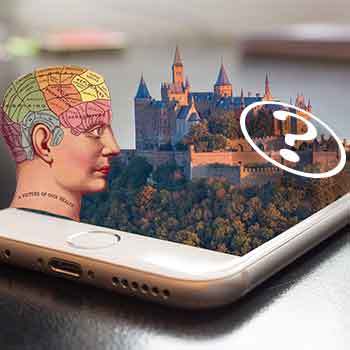 Have you ever installed a brain exercise apps on your smartphone?
Have you ever installed a brain exercise apps on your smartphone?
If so, don’t worry. You’re not alone.
Let’s face it:
The allure of increasing your brain’s cognitive performance has tempted over 70 million users to a famous app in the course of just one decade.
And to be honest:
The attraction is justified.
Why?
Because every functioning human uses their brain. Increasing its capability can only serve us better as we go about our daily lives.
Now, look:
There is no doubt that technology has made our lives more convenient. Mobile clearly makes technology more portable. And the nature of mobile technology has made many apps completely free.
However, “free” is not always a good thing.
Many brain exercise apps cause undesirable habits that can be toxic to our overall health.
This leads to the following question:
Are brain exercise applications really effective in improving the brain, or do they actually hinder its development?
Brain Exercise Apps – The Big Lie
According to research by Joseph Kable, Caryn Lerman, and John Glick at the University of Pennsylvania, there is no evidence that brain exercise apps improve cognitive performance, working memory, or decision-making.

The study enlisted two groups for testing several brain functions. To begin, the scienctists recorded some baseline scores.
Next, one group played brain games, while the other played regular video games. After the initial experiment, the researches tested both groups again and both showed improvement in their brain function scores.
These results imply that the brain games did not do any better in terms of significant effect and both groups improved because they became more familiar with the test. This comfort, not improvements from brain training, caused the high scores.
In fact, the test participants developed a better understanding of the games they played. The exposure enhanced their playing strategies instead of the presumed increase in the brain function.
This University of Pennsylvania study was not a fluke.
You’ll find similar results in a study by Neil Charness, Wally Boot, and Dustin Souders of Florida State University. Their research showed that skills from these mobile apps were very specific and didn’t have a lot of carryovers to other tasks.
Are You Sabotaging Your Brain By Playing Brain Games?
At worst, brain games could simply waste our time. But could it be possible that these apps are also insidious and cause a hindrance in cognitive development?
Or is it possible that the complexity that mobile technologies introduced to our lifestyles explain the decline of our brain function?
Thinking about cognitive development may reveal answers. The growth of children and their capability to perceive, think, and maneuver through their surroundings involves intelligence, reasoning, memory, and language development.
Cognitive development is not only dependent on genetics but also on the environment in which the child grows. Moreover, cognitive development depends on the stimulus and interaction that he or she experiences.
No one can control genetics but you can try to provide stimulating learning materials and experiences to support the development.
But whether brain games fall into the category of stimulating learning materials is a question that needs more exploration. Like the real data you should know about Cogmed for brain exercise.
Parenting For Dummies, 1936 Edition
To determine the relationship of these apps to cognitive development, Jean Piaget’s Theory of Cognitive Development will be useful. What follows is a kind of walk-through, if you will, of how the human brain assimilate information throughout its developmental years.
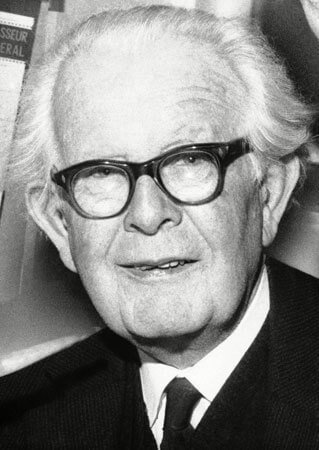
This process of assimilation is important because the brain uses it to navigate the world. According to this theory, the progress takes place gradually and in four successive stages.
First Stage – The Adjustment Period
The first stage is the sensorimotor stage. This first stage of cognitive development occurs during the child’s infancy. Infancy may seem like a short time but from birth the infant experiences a variety of physical and psychological interactions that cause many changes in a short period.
For soon to be parents, some highlights to expect are:
Newborns may already be able to focus and track moving objects
3 months, recognize faces and familiar sounds.
6 months, recognize their own parents and imitate familiar sounds
9 months, understand simple words
1 year, speak a few of these simple words and even associate names
1.5 years, vocabulary continues to grow
Your Baby Has Her Own Tablet?!
During this infancy, some parents will hand smartphones over to their children as a distraction. They think that because their kids can already manipulate the tablet and interact and tap images and symbols displayed on the screen, this activity is fine.
No one really knows. Smartphones and tablets have only been with us for a short while and the children that have been able to use smartphones and tablets early in their lives have yet to be studied. Smartphone addiction does seem to be a real thing though.

Yet, this much is already clear:
Too much screen time and less social interaction inhibit emotional and social development. Aside from that, studies also show that high-energy visible (HEV) light or blue light emitted by the screen can damage the eyes.
Why not get prepared to teach your kids memory techniques now so that you’re ready when they need you?
Second Stage – Pre-School Years
The second stage is the pre-operational stage that encompasses toddlerhood to early childhood.
Again, here are some cognitive development highlights:
2 years, vocabulary will have significantly increased again
3 years, familiarity with everyday routines like changing clothes and playtime
3 – 6 years old, capability to use imagery and memory skills
Spotting Early Signs of Disability
Of course, it is a different scenario when the child has autism or learning disabilities. Such conditions manifest as difficulties in oral and written language, coordination, and attention and can usually be spotted around the age of 3. Trouble understanding simple instructions or being confused with simple tasks are typical signs of congitive problems.
A delay in cognitive development, as well as several other factors, can contribute to these difficulties. It is best to consult a doctor before engaging in any brain exercise routines.
Tablets versus Toys
Ages 3-6 is a phase where children start learning to read and developing routines like doing chores. This is also the period where their attention span increases to about 15 minutes. Obviously, memory development is huge during this time.

Since this is a stage that focuses on imagery, apps can provide much more stimulus and interaction than analog pictures.
Years ago, when preschoolers learned about tigers, teachers showed children pictures in books. Current technology allows preschoolers today to see that same tiger in a video, in vivid colors, and with sounds.
Of course, this type of app does not really fit into a “brain exercise” category but belongs more to “multimedia education”.
That said, many apps blur the lines and there are no studies pertaining to long-term effects on cognitive development because the technology is only recent.
In other words, this is unchartered water for scientists. Yet, far too often, people make conclusions about the use of apps during these early stages of life.
Worse:
Parents now depend on these apps instead of multiple analog toys littered around the house.
On the one hand, it makes sense:
You only need one tablet for the child to play a nearly unlimited number and type of puzzles. The devices also distract children and prevents quarrels with siblings, (unless they quarrel over the tablet or smartphone itself).
Digital Friend versus Human Interaction
Based on studies, this is also the stage where the child develops social interaction skills such as playing and cooperating with other children. Replacing physical activities and social interactions with too much focus on the tablet or smartphone will hinder social development. The research of Patricia Greenfield and her team at UCLA has done much to clarify this problem.
Of course, there are many other factors to consider at this stage. But no matter how you approach things, it’s best to be involved with your children as they play with tablets or smartphones so that they understand the limits as you supervise and provide them interaction while still allowing them the benefits of digital stimulus.
Third Stage – The Concrete Operations Stage – The Calm before the Storm
The concrete operations stage will be at ages 6 – 12 where a lot of physical and personality changes occur. The use of apps at this stage would be similar to that of the previous stage.

But here’s a key difference:
During this stage, children are more able to think critically.
In terms of cognitive development, here is what you can expect:
6 years, capability use logic in thinking and solving problems
9 years, attention span will increase from 15 minutes to 1 hour
12 years, increased use of logic
Fourth Stage – Formal Operations – Nightmare Teen years are not as bad as you think
This is the age group most parents dread.
Nonetheless, it is an important stage in cognitive development because between ages 12-18 is the formal operations stage where children start to think hypothetically.
They also become better at abstract ideas that lead to reasoning, logic and the ability to understand religion, philosophy, and mathematics. They can think in different perspectives, allowing them to conceive of social issues in sophisticated ways.
Whereas children think in black and white, right or wrong, adolescents can think in relative terms. They start to question authority and absolute truths. Socialization will be a key issue here as the adolescent spends more time facing a screen than interacting with friends. But if your teen is buried in an app, they risk not developing these cognitive abilities.
When Does Cognitive Development Stop?
Of course, in real life, hitting age 18 does not turn you into stone. You continue to age physically and mentally. Cognitive development does not stop because a person does not stop perceiving, understanding, and reacting to the environment in which he or she moves. You continue to learn and the physical structures of your brain undergoes continual change.
Why Adults Never Stop Learning
From age 17 to 45, the average individual will learn “practical street smarts”. He or she can still use reason and logic, solve theoretical problems, and understand abstract concepts, but he or she now has the added benefit of life experience.
For example, you may have realized that you get better brain exercise from reading physical books instead of ebooks:
In some studies, older adults tend to perform better in tests of crystallized intelligence. This intelligence is the ability to use learned information collected throughout the lifetime. This makes sense because they naturally have collected more information than a younger person.
Meanwhile, a young adult will perform better on fluid intelligence. This type of intelligence is the ability to think in abstract and new situations.
Generally speaking, younger adults have higher IQ than their adult counterparts. However, this difference may be due to the difference in technology.
Whereas many adults today only had access to television and printed reading material during their developmental years, younger adults had access to the Internet. Differences in information consumption may be the source of the difference in IQ.
We can only guess what the effects are of earlier access to electronics, virtual reality, social media, and other modern-day education to the next generation of adults.
At 45-65, the years of insight typically allows the person to make compromises and work through disputes and contradictions in their religion and beliefs.
Senior Years – Retired but Not Expired
At age 65 and higher, research does not support that aging makes you lose the capability to use cognitive reasoning. And if there is a reduction, it will not be sufficient to be problematic in your day-to-day life unless you suffer from a complication (e.g. Alzheimer’s disease).

However, many people complain that they are starting to have memory loss problems. Often, these reflect only short-term memory complaints because these people can still recall information from a long time ago but forget recent information.
During these advanced ages, studies like those completed by Alden Gross and colleagues in 2012 show that memory training would be very useful in arresting the decline of brain function in general.
For example, working memory allows us to retrieve and process several chunks of information to perform a task. For that reason, it is important that this function is retained for as long as possible. And using certain brain exercises, working memory can be trained and kept in top shape well into old age.
Unlocking Hidden Brain Performance
Instead of increasing the amount of “playing time” in these apps, you improve other aspects of your life that affect not only brain function, but physical performance as well.
One factor that affects brain performance is fatigue in the form of physical exhaustion. Check out a study by Hoda Abd-Elfattah, Faten Abdelazeim, and Shorouk Elshennawy for more information about this issue.
Of course, fatigue only means that it is harder for our brains to function when we are tired.
But physical activity, in general, is healthy for the brain. In fact, a study by Laura Baker and colleagues at Wake Forest School of Medicine in North Carolina showed that aerobic exercises improve cognitive function.
Avoid Poisoning Your Brain!
You really do need to take care of your physical body. Magnetic resonance images of the brains of alcoholics show decreased volume while smoking causes cognitive decline. Lack of sleep can also cause reductions in brain performance.
Diet also plays a key role. Ketogenic diets are currently popular and a study by Robert Krikorian and colleagues published in 2010 shows that dietary ketosis can enhance mild cognitive impairment.
But I Want to Play Brain Games!
There’s no doubt that brain exercises develop specific skills that benefit people from different walks of life.
For instance, old-time monks use methods like meditation while modern police forces use specific memorization techniques to improve the process of intelligence gathering. Most of these brain training activities are simple and require no external instruments.
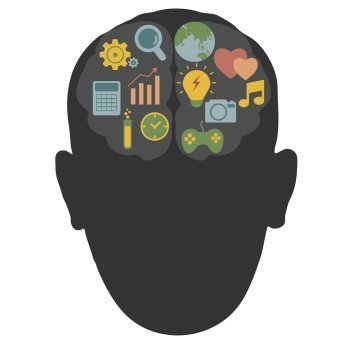
Unfortunately, brain exercise in the minds of most people involves a tablet or smartphone full of brain exercise apps. But the research just doesn’t support the claims that these apps are helping anyone.
Don’t fret if research shows that these brain game apps don’t work. There is a lot of other research on this site loaded with activities that do work to improve memory and brain function.
But, if you still insist on playing brain game apps, then go ahead if you find it enjoyable. Not everything you do must have a quantitative result. But don’t forget to spend quality time in the real world as well with your real memory.
And protect your memory at all costs. You’re the only one who can.
The post Brain Exercise Apps: Do They Help Or Hinder Cognitive Development? appeared first on Magnetic Memory Method - How to Memorize With A Memory Palace.
August 15, 2018
5 Memory Palace Examples To Improve Your Memory Training Practice
 Have you been looking for Memory Palace examples?
Have you been looking for Memory Palace examples?
They can be tough to find, especially since many people, like Sherlock Holmes, prefer the term “Mind Palace.”
Plus, people use terms like “peg word system” and “Method of Loci” when looking for Memory Palace training, and it can all get a bit confusing.
Although we can’t cover every type of Memory Palace, get this:
On this page I’ll give you 5 powerful Memory Palace examples you can use to improve your memory training practice.
But before you read, I suggest you begin with this video:
Now that you have enjoyed that broad overview of Memory Palace Training Exercises and what to expect, let’s properly define the Memory Palace technique.
Why Nearly Every Memory Technique Serves
As A Method Of Loci Example
This point might be hard to grasp at first, but this is important:
The Memory Palace, sometimes called the Method of Loci, is based on the same core principle that governs all information.
This principle is space.
You see, your brain encodes information chemically in the brain.
Each neuron and neural network in your brain exists in space - the space of your brain.Click To Tweet
And according to Stephen Kosslyn, there’s a kind of one-to-one correspondence between information out in the world and where your brain stores it in the brain.
In other words:
Your Brain Is A Memory Palace Book
Hear me out:
Imagine that your brain really was a book.

And each page of that book is covered in words.
Now imagine that each page in that book is a neural network that binds all of its words.
Likewise, the neural networks in your brain bind the neuronal chemicals that store you memories.
Of course, the brain and memory are much more complex than any metaphor or analogy can express.
But all of this leads to the same conclusion:
If Your Brain Is Like A Computer…
It’s More Like A Kindle Than A Laptop
Think about it:
If a book is an information storage and retrieval device that uses the space of pages, then the computer version of books do pretty much the same thing.

This fact means that your Kindle app also stores each word in space on a hard drive and a screen.
And so if you think about how books and apps relate to your memory…
The Ultimate Mind Palace App Is Your Brain!
Isn’t that exciting?
I sure think so. And that’s why I produce so much Memory Palace training for the world.
Do You Have A Memory Palace Sherlock Would Admire?
We’re going to get back to the all-important point about space in a moment. But first:
To create a proper Memory Palace in the space of your brain, it’s important to move beyond fictional characters like Sherlock Holmes and get the right Memory Palace training:
Next, turn your brain into a Memory Palace app by studying from the best types of Memory Palaces.
1. The Bird’s-eye/3rd Person Memory Palace
This kind of Memory Palace involves looking down through the roof on a building. It’s as if you’re looking down at a floor plan.
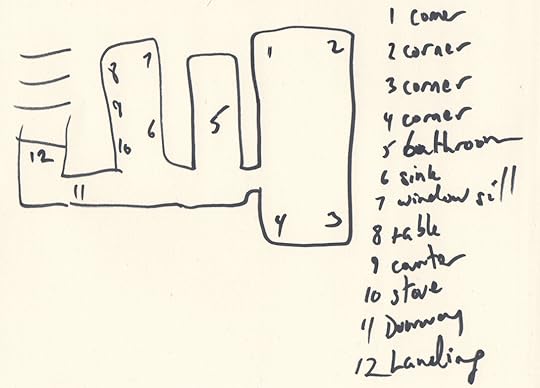
2. The 2nd Person Memory Palace
In this kind of Memory Palace, you look at yourself or a Bridging Figure move through your Memory Palace as if through the lens of an external camera.

3. The 1st Person Memory Palace
Using this kind of Memory Palace, here’s what happens:
You imagine yourself in the Memory Palace. You then imagine yourself seeing the journey you are following through your own eyes.
You can also pretend to be a character in a video game, series or movie and see through the eyes of that character.
For example, using an outdoor Memory Palace, I could imagine being this Giordano Bruno statue and see parts of Rome I’ve created as Memory Palace as if through his eyes:

4. The Virtual Memory Palace
At some level, all Memory Palaces are Virtual Memory Palaces.
Why?
You are creating an imaginary construct. This construct is based on a building or area you’ve seen in real life. You are navigating it “virtually” in your imagination.
That said, when you’re basing a Memory Palace on a location you’ve seen with your own eyes, you seriously reduce cognitive load.

Think about it this way:
When you last moved into a new home, did you have to work hard to memorize the layout?
Probably not. That’s what makes calling it to mind so easy.
But if you’re using a video game as a Memory Palace, not only do you have learn the layout in a completely different way.
You also have to re-create that layout using more mental resources because you’ve never really been there.
Caution:
This not may not be true for all people.
But I think for most us, Virtual Memory Palaces will cost more time and energy than they are worth.
5. The Magnetic Memory Palace
This kind of Memory Palace lets you fuse all the first four approaches together into one seamless Memory Palace strategy.
Recall Rehearsal also makes memory practice feel a lot like a Memory Palace game!
In fact, when you use the Magnetic Memory Method tools of…
Sea shelling
The Pillar Technique
& ample use of Magnetic Bridging Figures…
Everything gets much easier. That’s because it becomes more fun.
Not only that, but the Magnetic Memory Palace, when used as part of a full Memory Palace Network, makes Recall Rehearsal faster and easier as well.
(Recall Rehearsal is a fast and fun “memory game” way to get any information into long-term memory quickly.)
For a longer discussion of these five approaches to navigating your Memory Palace, check out this video:
The Best Memory Palace For Studying For
School Or Large Learning Projects?
Now, you might wonder, which of these Memory Palace approaches are best for studying for learning.
Ultimately, you need to experiment.
And I would suggest that you learn to use a Magnetic Memory Palace as quickly as possible. Then learn How To Renovate A Memory Palace.
The first three options require too much time and energy. You’ll spend more time visualizing your Memory Palace and your journey through it than necessary.
The Ultimate Truth About Memory Palace Examples & Exercises
Always remember that memory champions simply don’t have time to visualize their Memory Palaces.
They might “see” glimpses, but there’s something quite different going on.
And anyone can learn to reduce the need to visualize their Memory Palaces and journeys with just a bit of practice.
Practice Using Your Brain And You’ll Be The
Best Memory Palace App On The Planet
There are a lot of Memory Palace software programs available.
Frankly, they all present a deviation from developing true memory skills. Like the Giordano Bruno memory skills of legend.
For thousands of years people managed to memorize a textbook without apps or programs.
In fact, it might be precisely because computers have created Digital Amnesia that people no longer pick up these high level memory skills more often.
Why Real Memory Palace Training Is Always Organic
For research purposes, I’ve spent a lot of time in Memory Palace training with apps.
This activity has always been interesting, but ultimately always a waste of time.
Here’s why:
When you train your memory to use a Memory Palace with an app, you’re training in a digital environment.
And if you want to at events, that will give you a bit of an advantage. Here’s more information on how to remember names fast on this live stream replay:
Just remember:
The only Memory Palace examples that matter involve the practice memorizing names at real events – unassisted by technology.
And I have found that training for names using a Memory Palace reduces my skills instead of increasing them.
And little wonder:
Real-life events do not take place on apps - they happen in the world!Click To Tweet
Just ask Jesse Villalobos about how he got a promotion, featured on this Magnetic Memory Method Review.
The Best Memory Palace Examples For Language Learning?
If you want to learn a language, you might like to use a Memory Palace strategy.
There are many ways to proceed, but I’ve found the best involves creating a Magnetic Memory Palace Network around the alphabet.
The alphabet is an interesting mental tool that exists in space. The letter B falls to the right of the letter A, R falls to the left of S and so on.
In other words, the alphabet is a fixed linking system that everyone knows by default – exactly like you know the layout of your home. This understanding makes memory training far more powerful than the old fashioned “method of loci” will ever be.
And that’s why it’s so easy for each letter of the alphabet can serve as a kind of mnemonic peg system you attach to a building.
I suggest that you start with just one Magnetic Memory Palace Network first.
Then create another one until you fully feel the effects of spatial memory working its magic in your mind.
You’ll begin to sense exactly why the Memory Palace is the most powerful technique and why all the other techniques, including the Major Method, are all spatial in nature.
That’s all for now, but I hope that these Memory Palace examples have given you some food for thought and ideas to model for your own memory improvement practice.
Let me know in the comments below if you have thoughts or questions.
You got this!
The post 5 Memory Palace Examples To Improve Your Memory Training Practice appeared first on Magnetic Memory Method - How to Memorize With A Memory Palace.
August 7, 2018
The 3 Most Powerful Memory Techniques For Memorizing Numbers
 If you want to know how to memorize numbers, you might be getting frustrated.
If you want to know how to memorize numbers, you might be getting frustrated.
After all, there is a ton of confusing information about the main remembering numbers technique known as the Major System.
There’s also the question of just how many numbers can a person remember? Not to mention how to remember numbers with a Memory Palace.
In this post, I will show you:
The Major System that allows you memorize numbers with letters and words.
How to connect the Major System with a Memory Palace.
How to expand the Major System into a PAO or 00-99 system.
Or you can just watch the video version of this lesson:
No matter how you choose to learn these techniques, this is important:
Your goal is to shift the burden of memorizing numbers to remembering fun and straightforward images.
This simple activity will reduce the cognitive load on your brain and make learning and remembering any number exciting and fun.
Simple Mnemonic Examples Of How To Memorize Numbers
Have a look at this image:

This is a nun.
She represents the number 22 in the 00-99 Major System I use.
Every time I see 22, I bring this nun to mind (I actually imagine Mr. Bean dressed as a nun. More on why later…)
I do this because if I next see the number 235, I can see an animal, it’s easy for me to use the Major System (better described as the Major Method) to add another image.
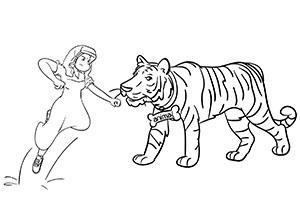
When the nun interacts with the animal in an unusual way, I’m able to remember a longer digit with ease: 22357.
The Major System That Underlies The Remembering Numbers Technique
To get to the stage where you can use nuns and animals, you need to understand why 22 is a nun and 235 is an animal.
The Major System has different terms, including:
The Phonetic Number System
Phonetic Mnemonic System
Number Consonant System
Herigone’s Mnemonic System
… and more.
The exact history of it is not known, but in Mind Map Mastery, Tony Buzan attributes it to Johann Just Winckelmann.
Others site Aimé Paris and Major Beniowski, from whom we most likely take the name, Mnemonic Major System.
Although there are many variations and you can make up your own, a large number of people use an arrangement like this:
0 = soft c, s or z
1 = d, t
2 = n
3 = m
4 = r
5 = l
6 = ch, j or sh
7 = k
8 = f or v
9 = b or p
In this way, I came up with Nun for 22, but perhaps you would prefer a piece of naan bread. Try to make sure that you have a vowel between the two consonants, but if that doesn’t work for you, a word like “onion” is also acceptable.
It’s really up to you, but I suggest that you avoid abstract concepts like “noon.” If you want to use “noon,” make sure it is a clock with its hands pointed at noon, and maybe include Gary Cooper who starred in High Noon to make it even more concrete.
Likewise with a word like “anon.” This word could make an excellent Magnetic Image for 22, but only if you make it concrete, such as by having James Woods with a particular book.
Why James woods? Because he starred in My Name is Bill W. about the origins of Alcoholics Anonymous.
I realize this specificity requires you to stretch your imagination, but its excellent brain exercise (better than any app) and is the secret of how to get a solid 00-99 working from the beginning. (Instead of having to fuss with it for years and potentially give up, as others sadly do.)
How To Expand Your Major System Into A Full 00-99 List
To expand the rules that underly the phonetic Major System is easy. I suggest you take it 5-10 sets at a time.
But first, get a Memory Journal so you have a place to chart down your ideas on paper.
Overall, the best way to learn how to memorize numbers using this approach would go like this:
1. Get a Memory Journal for completing the creative task
2. On a new page, copy the start with 00 and write all the numbers up until 10.
3. Starting with 00, think of words that begin and end with ‘S.’ I personally use Thomas Szasz, but many use Dr. Suess. Sissy Spacek would also work or a pair of eyeglasses built by Zeiss. Many other options are equally concrete. If you choose Zeus, use the character from Planet of the Apes or a clear painting or cartoon of Zeus so you’re not relying on a vague concept.
4. Proceed to 01. For me, this is “sad,” and I see the tragedy mask worn by William Shatner in his performance of Oedipus Rex.
5. Keep going for about 5-10 minutes and take a break. It’s important to relax and revive your creative muscles.
How To Memorize Numbers Encoded With Images In A Memory Palace
First things first, you’ll need to know how to create a Magnetic Memory Palace. Here’s your ticket for that:
Next, start with your first Magnetic Station in the Memory Palace. If you used Dr. Suess, place him on the first Magnetic Station. If you used the sad tragedy mask for 01, place it on the next station.
You can do this in small sets or get more ambitious and work on larger sets. The critical point is that you use Recall Rehearsal to get the images into long-term memory.
For many people, this step will not be necessary because they can deduce like Sherlock Holmes what their images are by relying on the Major System.
For example, I didn’t learn my 00-99 using a Memory Palace. I only needed to think about the Major for each digit and track back to the image I chose.
The Major Mistake I Made When Creating My
First Phonetic Mnemonic System
When I created my first list for math based on the science of mnemonics, many of the images were not concrete enough.
To this day, I keep strengthening them and find many opportunities to do so. For example, I use to have a very generic idea of “fire” for 84.
But I later evolved this image to Chuck Norris in Missing in Action 2 with a flamethrower. I did not have to invent this image because there is a classic scene in the movie where he burns down a bridge with a flamethrower.
And that is the beauty of using the Major Method to memorize numbers. By letting its rules set you free, your imagination will come up with many powerful associations. It is also a great way to strengthen your ability to make associations if you need the developmental exercise. (Many people do.)
How To Extend Your 00-99 to A Person Action Object System
So far we’ve talked about giving each digit an image from 00-99.
Many people like to have a triple-whammy effect by having at least three different elements going on for each digit.
To be honest, I have never found this necessary or entirely useful in everyday life. However, in the world of memory competition, it is a must.
That said, my own method of working often includes most of Person Action Object criteria.
For example, the 01 tragedy mask is both a person and an object: It is the tragedy mask (the object) worn by William Shatner (the person). To add an action would be easy: he could be soaping it up with suds.
Although I would be making a leap of the imagination by turning “suds” into a verb, this could work very well.
To take another example, I have Jim Carrey with a lyre (stringed instrument) for 54. I could have him using it to “lure” something or someone to add an action, but I don’t need this specificity for my personal memory practice.
The reason I don’t have a full PAO (sometimes falsely lumped in as a Mnemonic Peg System) for each digit is that I prefer flexibility. In real life, you do not have to beat the clock the same way you do in a memory competition.
You are also using numbers you want to memorize for the long term, like banking info, phone numbers and passwords. These are not random digits heard or read at an event that you’re going to forget minutes after submitting your results.
To that end, I prefer to choose how my Magnetic Images interact with each other on the fly.
Obviously, this approach is different than the Dominic System (or Hotel Dominic) or the system Ben Pridmore uses, etc.
And at the end of the day, that’s the incredible and mind-blowing truth:
Tony Buzan is right:
The rules will set you free.
Each person always uses these techniques individually. And although ultimately you must find your own path, you are free to do so by leaning on the classic techniques and paying attention to the Magnetic Memory Method principles of being specific and concrete. And of course there’s more to learn in How to Memorize Math, Numbers, Simple Arithmetic and Equations.
And now that you know the options available to you, you can easily learn how to memorize numbers quickly. Because…
Learning To Use Mnemonics For Numbers Is Easy And Fun!
Now that you have these strategies, I suggest you listen to my interview with Brad Zupp. He explains his story and perspective from the realm of competition and practical use of these techniques as a mental passwords manager.
How do these approaches to remembering numbers strike you?
If you have any experiences you’d care to share or have any questions, post them below.
You got this!
The post The 3 Most Powerful Memory Techniques For Memorizing Numbers appeared first on Magnetic Memory Method - How to Memorize With A Memory Palace.




